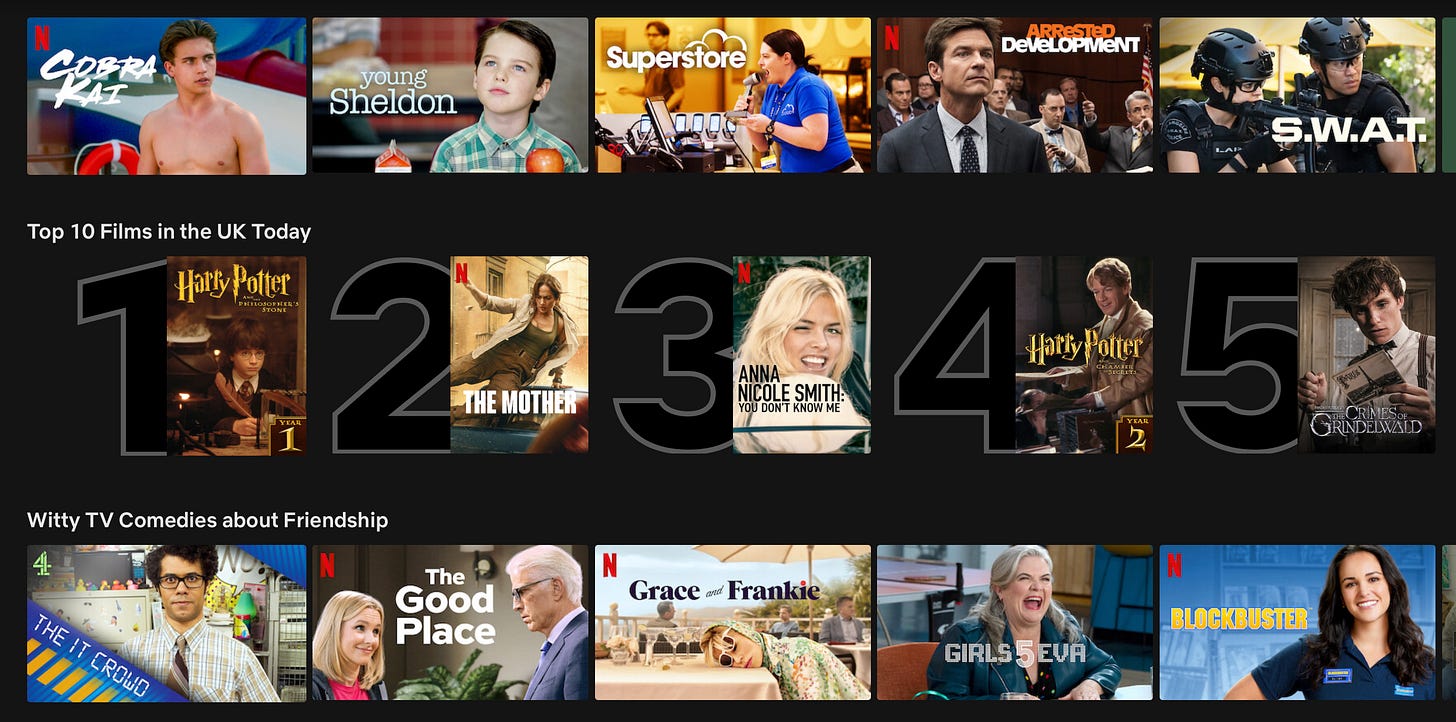Messaging velcro (cloaked in comedy)
9 under-the-radar marketing lessons hiding in a comedy podcast
My podcast library Saved folder has slowly turned into the digital version of the pile of unread books by my bedside table. If the Japanese word for stockpiling untouched books is tsundoku, what’s the podcast equivalent?
I cheated and prompted ChatGPT for an answer. Everyone’s favourite AI word-spitter produces marketing copy that’s only readable (at best), but it’s Rain Man at jobs like this.
So are you a procrastipod too?
I often tend to podcrastinate.
Sometimes I even feel podstipated.
Digressing in the intro. Back to podcasts.
Aside from that unconquerable mountain of Saved episodes, I have a few ultra-reliable shows that I always listen to.
Everyone Hates Marketers for industry truths delivered in a French accent.
Happier with Gretchen Rubin for thoughtful advice on habits.
Something Rhymes with Purple for knowledgeable ramblings on words and language.
And Help I Sexted My Boss for guaranteed giggles.
Here’s the concept.
The hosts of Help I Sexted My Boss are two unlikely friends - etiquette expert William Hanson and radio presenter Jordan North.
The pair responds to listener dilemmas about etiquette issues, each giving their own take on the rules of engagement in 21st century society.
Holding the 4th spot, at the time of writing, in Apple’s top comedy shows, Help uses at least 9 smart messaging techniques to plant its flag in podcast land.
9 messaging smarts to steal from a comedy podcast
1 Create a ritual
William and Jordan pour themselves a Gin and Dubonnet at the start of every single episode. They’ve even got a joke on repeat about the sound of the bottle opening.
If you can connect your brand or product to a ritual, it can be messaging gold. This kit on how to create rituals in secular life is useful, if you want to generate some ideas.
2 Name your insiders
Technically known as familect, made-up words for a group make insiders feel like family. This behind-the-scenes language helps people feel in the know. They become part of the clan.
That’s why copywriter Laura Belgray celebrates her Shrimpers (check out her home page below).
And also why William and Jordan toast their G & Divas every episode (riffing on the Gin & Dubonnet ritual).
3 Repeat “in the know” stories
A clever follow-on from using familect, the pair often refers to ‘in the know’ jokes from previous episodes, eg Jordan’s story about The Gay Ghost (Help I Sexted My Boss S11, ep2).
4 Play your core message on repeat
The more we see or hear something, the more we like it. That’s simply a brain bias known as the Familiarity Principle, or Mere Exposure Effect.
It’s also an argument for never straying too far from your main message.
Your core message sums up the simplest way to explain what you offer. It must contain a message that your audience actually cares about.
That’s why the Help duo repeats the same intro message every episode, which always ends with the words (and contemporary conundrum) - What should you do if you’ve accidentally sexted your boss?
5 Create an earworm
Think of the ads you remember from childhood. How many had a catchy jingle that you can still harmonise with years later? Just One Cornetto? Do the Shake n Vac?
Sonic branding is a marketing niche with its own specialists. Learn more here about psychoacoustics and how sound affects consumer behaviour.
Earworms are a subset of the sonic branding genre that also includes the manufactured sound of a luxury car door closing. They give our brains subconscious signals about a brand. They’re particularly appealing and memorable for our pattern-loving brains.
Jingles like Jordan’s Jolly Joke of the Week in the podcast are brand recognition flypaper.
6 Lean into storytelling tropes & archetypes
Storytelling is an overused buzzword in marketing. Here’s what I think it actually means.
Give us stories in patterns that we recognise, so that our brains can’t wait to fill in the gaps.
To make this goal less mysterious, marketers can use character archetypes and story tropes. The Help podcast includes some tropes that you’ll recognise from popular culture.
Once you look at these examples, you’ll be able to think of loads more.
Unlikely best friends, like Grace and Frankie.
Interclass friendship, like Margo and Barbara. Or if you’re too young to remember The Good Life …
… the odd couple, like Bert and Ernie, Laurel and Hardy, Jeeves and Wooster, Mitchell and Webb.
Opposites attract, like Johnny and Roland in Schitt’s Creek or Sam and Diane in Cheers.
Popular (and highbrow) culture contains so many examples of these story tropes. Dive into the TV Tropes website for inspiration, if you’re a marketer aiming to be a storyteller.
The entertainment industry even has a name for the central premise of Help I Sexted My Boss. It’s called The Wunza Plot.
Here’s how The Wunza Plot works. It’s simple - One’s a … and One’s a …
In this case, one’s posh and one’s an expert in “all things common”.
Our brains, which naturally enjoy patterns, subconsciously understand (from generations of examples like these) that the story gets interesting when opposing worlds collide and the unlikely duo learns from each other.
7 Get nostalgic (& personal)
William promises an old-school handwritten letter to listeners who write to the show. It’s a smart move.
There’s ample scientific evidence behind the power of handwriting in marketing, whether it’s used on product packaging or service materials.
Human effort isn’t always required, as even handwritten typefaces can improve marketing outcomes.
Read this from the Journal of Business Research on handwritten typefaces in restaurant menus.
Or this from Psychology & Marketing on the power of the pen, and how handwritten fonts promote haptic engagement.
8 Use Netflix-style visuals
While this post focuses mainly on language and messaging, we can’t ignore the powerful influence of visuals.
So how can you design visuals that captivate attention by leveraging the principles of evolutionary psychology?
One answer is to use Netflix-style faces - expressive human faces placed front and centre, set against contrasting colours.
Doesn’t it make sense to borrow some smarts from this big brand that presumably invests heavily in research?
Look at this screenshot of a Netflix home screen. Spot the common threads?
Every thumbnail includes at least one face (but not too many).
Most faces are ultra-expressive.
Titles are often in line with, or close to, the characters’ eyelines.
Now look at the thumbnail for the Help podcast. Spot any similarities?
Expressive faces on a contrasting background.
Supersized word “HELP” in red letters (how can our brains ignore that, when we’re primed by emergency messages and road signs?)
“Rays” radiating from the central image, so that our brains and eyes are subconsciously drawn to it.
9 Find a repetitive mantra
The guys on the Help podcast take this to the next level. They don’t just have a mantra, they’ve got a “call and response” catchphrase.
It feels like it came about by accident, from a story Jordan told about his mum and neighbour.
And now the duo hears this wherever in the world they go … “Wendy … can i borrow your potato peeler?”
If you know, you know.
Messaging by stealth: summary of takeaways
Create a ritual
Name your insiders
Repeat ‘in the know’ stories
Play your core message on repeat
Create an earworm
Lean into storytelling tropes & archetypes
Get nostalgic (and personal)
Use Netflix-style visuals
Find a repetitive mantra
Stealth messaging: how to do it?
Think about how you could apply these 9 takeaways to your own messaging.
Can you tweak your visuals to include a face? Read more about the power of faces in marketing here.
How memorable are your one-liners? Do they need reshaped?
Could your business storytelling benefit from a psychology power-up? What story tropes can you use?
Can you invent a special insider name for your people? Or think of a ritual to associate your business with?
I fix business messaging using copy psychology, if you need more help.
And listen to Help I Sexted My Boss. You won’t regret it.












Have you seen there's a Sexted newsletter too? sextedmyboss.com/newsletter